The Thermal Effect of Submarine Mud Volcano Fluid and Its Influence on the Occurrence of Gas Hydrates
Abstract
:1. Introduction
2. Geological Setting
3. Data and Methods
3.1. Characterization of HMMV Using Seismic, Well Logging, Drilling and Heat Flow Data
3.2. Håkon Mosby Mud Volcanic Fluid Thermodynamic Simulation Method
3.2.1. Temperature Variation of the Thermal Fluid at Different Depths in the Mud Volcanic Conduit
3.2.2. Effects of Mud Volcano Thermal Fluid on Surrounding Sediment
4. Results
4.1. Vertical Temperature Distribution within the Mud Volcano Conduit
4.2. Temperature Variation of Gas Hydrate Occurrence Layer
5. Discussion
5.1. Temperature Anomalies in the Mud Volcano Development Area
5.2. Influence of a Mud Volcano Fluid Thermal Anomaly on Gas Hydrate Distribution
6. Conclusions
Author Contributions
Funding
Institutional Review Board Statement
Informed Consent Statement
Data Availability Statement
Acknowledgments
Conflicts of Interest
References
- Kopf, A.J. Significance of mud volcanism. Rev. Geophys. 2002, 40, 2-1–2-52. [Google Scholar] [CrossRef] [Green Version]
- Milkov, A.V. Worldwide distribution of submarine mud volcanoes and associated gas hydrates. Mar. Geol. 2000, 167, 29–42. [Google Scholar] [CrossRef]
- Dimitrov, L.I. Mud volcanoes-the most important pathway for degassing deeply buried sediments. Earth-Sci. Rev. 2002, 59, 49–76. [Google Scholar] [CrossRef]
- Dimitrov, L.I. Mud volcanoes—A significant source of atmospheric methane. Geo-Mar. Lett. 2003, 23, 155–161. [Google Scholar] [CrossRef]
- Wing, B. Archaean biogeochemistry: Unexpectedly abiotic. Nat. Geosci. 2012, 5, 598–599. [Google Scholar] [CrossRef]
- Wan, Z.; Xu, X.; Wang, X.; Xia, B.; Sun, Y. Geothermal analysis of boreholes in the Shenhu gas hydrate drilling area, northern South China Sea: Influence of mud diapirs on hydrate occurrence. J. Pet. Sci. Eng. 2017, 158, 424–432. [Google Scholar] [CrossRef]
- Poort, J.; Khlystov, O.M.; Naudts, L.; Duchkov, A.D.; Shoji, H.; Nishio, S.; De Batist, M.; Hachikubo, A.; Kida, M.; Minami, H. Thermal anomalies associated with shallow gas hydrates in the k-2 mud volcano, lake baikal. Geo-Mar. Lett. 2012, 32, 407–417. [Google Scholar] [CrossRef]
- Feseker, T.; Foucher, J.P.; Harmegnies, F. Fluid flow or mud eruptions? sediment temperature distributions on håkon mosby mud volcano, sw barents sea slope. Mar. Geol. 2008, 247, 194–207. [Google Scholar] [CrossRef]
- Vogt, P.; Cherkashev, G.; Ginsburg, G.; Ivanov, G.; Milkov, A.; Crane, K.; Sundvor, A.; Pimenov, N.; Egorov, A. Haakon mosby mud volcano provides unusual example of venting. EOS Trans. Am. Geophys. Union 1997, 78, 549–557. [Google Scholar] [CrossRef] [Green Version]
- Eldholm, O.; Sundvor, E.; Vogt, P.; Hjelstuen, B.; Crane, K.; Nilsen, A.; Gladczenko, T. Sw barents sea continental margin heat flow and håkon mosby mud volcano. Geo-Mar. Lett. 1999, 19, 29–37. [Google Scholar] [CrossRef]
- Kaul, N.; Foucher, J.P.; Heesemann, M. Estimating mud expulsion rates from temperature measurements on håkon mosby mud volcano, sw barents sea. Mar. Geol. 2006, 229, 1–14. [Google Scholar] [CrossRef] [Green Version]
- De Beer, D.; Sauter, E.; Niemann, H.; Kaul, N.; Foucher, J.P.; Witte, U.; Schlüter, M.; Boetius, A. In situ activity in surface sediments of the håkon mosby mud volcano. Limnol. Oceanogr. 2006, 51, 1315–1331. [Google Scholar] [CrossRef]
- Ginsburg, G.; Milkov, A.; Soloviev, V.; Egorov, A.; Cherkashev, G.; Vogt, P.; Crane, K.; Lorenson, T.; Khutorskoy, M. Gas hydrate accumulation at the haakon mosby mud volcano. Geo-Mar. Lett. 1999, 19, 57–67. [Google Scholar] [CrossRef]
- Milkov, A.V.; Vogt, P.R.; Crane, K.; Lein, A.Y.; Sassen, R.; Cherkashev, G.A. Geological, geochemical, and microbial processes at the hydrate-bearing håkon mosby mud volcano: A review. Chem. Geol. 2004, 205, 347–366. [Google Scholar] [CrossRef]
- Pape, T.; Feseker, T.; Kasten, S.; Fischer, D.; Bohrmann, G. Distribution and abundance of gas hydrates in near-surface deposits of the håkon mosby mud volcano, sw barents sea. Geochem. Geophys. Geosyst. 2011, 12, 1–22. [Google Scholar] [CrossRef] [Green Version]
- Glørstad-Clark, E.; Faleide, J.I.; Lundschien, B.A.; Nystuen, J.P. Triassic seismic sequence stratigraphy and paleogeography of the western barents sea area. Mar. Pet. Geol. 2010, 27, 1448–1475. [Google Scholar] [CrossRef]
- Volkov, D.L.; Kubryakov, A.A.; Lumpkin, R. Formation and variability of the lofoten basin vortex in a high-resolution ocean model. Deep Sea Res. Part I Oceanogr. Res. Pap. 2015, 105, 142–157. [Google Scholar] [CrossRef]
- Faleide, J.I.; Gudlaugsson, S.T.; Jacquart, G. Evolution of the western Barents Sea. Mar. Pet. Geol. 1984, 1, 123–150. [Google Scholar] [CrossRef]
- Faleide, J.; Myhre, A.; Eldholm, O. Early tertiary volcanism at the western Barents Sea margin. Geol. Soc. Lond. Spec. Publ. 1988, 39, 135–146. [Google Scholar] [CrossRef]
- Faleide, J.; Gudlaugsson, S.; Eldholm, O.; Myhre, A.; Jackson, H. Deep seismic transects across the sheared western barents sea-svalbard continental margin. Tectonophysics 1991, 189, 73–89. [Google Scholar] [CrossRef]
- Johansen, S.; Ostisty, B.; Fedorovsky, Y.; Martirosjan, V.; Christensen, O.B.; Cheredeev, S.; Ignatenko, E.; Margulis, L. Hydrocarbon potential in the barents sea region: Play distribution and potential. In Norwegian Petroleum Society Special Publications; Elsevier: Amsterdam, The Netherlands, 1993; Volume 2, pp. 273–320. [Google Scholar]
- Perez-Garcia, C.; Safronova, P.; Mienert, J.; Berndt, C.; Andreassen, K. Extensional rise and fall of a salt diapir in the sørvestsnaget basin, sw barents sea. Mar. Pet. Geol. 2013, 46, 129–143. [Google Scholar] [CrossRef]
- Faleide, J.I.; Vågnes, E.; Gudlaugsson, S.T. Late mesozoic-cenozoic evolution of the south-western barents sea in a regional rift-shear tectonic setting. Mar. Pet. Geol. 1993, 10, 186–214. [Google Scholar] [CrossRef]
- Blaich, O.; Tsikalas, F.; Faleide, J. New insights into the tectono-stratigraphic evolution of the southern stappen high and its transition to bjørnøya basin, sw Barents Sea. Mar. Pet. Geol. 2017, 85, 89–105. [Google Scholar] [CrossRef]
- Ryseth, A.; Augustson, J.H.; Charnock, M.; Haugerud, O.; Knutsen, S.M.; Midbøe, P.S.; Opsal, J.G.; Sundsbø, G. Cenozoic stratigraphy and evolution of the sørvestsnaget basin, southwestern Barents Sea. Nor. J. Geol./Nor. Geol. Foren. 2003, 83, 107–130. [Google Scholar]
- Eldholm, O.; Faleide, J.I.; Myhre, A.M. Continent-ocean transition at the western Barents Sea/Svalbard continental margin. Geology 1987, 15, 1118–1122. [Google Scholar] [CrossRef]
- Solheim, A.; Milliman, J.D.; Elverhøi, A. Sediment distribution and sea-floor morphology of storbanken: Implications for the glacial history of the northern Barents Sea. Can. J. Earth Sci. 1988, 25, 547–556. [Google Scholar] [CrossRef]
- Hjelstuen, B.; Eldholm, O.; Faleide, J.; Vogt, P. Regional setting of håkon mosby mud volcano, sw Barents Sea margin. Geo-Mar. Lett. 1999, 19, 22–28. [Google Scholar] [CrossRef]
- Andreassen, K.; Nilssen, E.G.; Ødegaard, C.M. Analysis of shallow gas and fluid migration within the plio-pleistocene sedimentary succession of the sw Barents Sea continental margin using 3d seismic data. Geo-Mar. Lett. 2007, 27, 155–171. [Google Scholar] [CrossRef]
- Faleide, J.I.; Solheim, A.; Fiedler, A.; Hjelstuen, B.O.; Andersen, E.S.; Vanneste, K. Late cenozoic evolution of the western barents sea- svalbard continental margin. Glob. Planet. Chang. 1996, 12, 53–74. [Google Scholar] [CrossRef]
- Gudlaugsson, S.; Faleide, J.; Johansen, S.; Breivik, A. Late palaeozoic structural development of the south-western Barents Sea. Mar. Pet. Geol. 1998, 15, 73–102. [Google Scholar] [CrossRef]
- Fiedler, A.; Faleide, J.I. Cenozoic sedimentation along the southwestern Barents Sea margin in relation to uplift and erosion of the shelf. Glob. Planet. Chang. 1996, 12, 75–93. [Google Scholar] [CrossRef]
- Jerosch, K.; Shlüter, M.; Foucher, J.P.; Allais, A.G.; Klages, M.; Edy, C. Spatial distribution of mud flows, chemoautotrophic communities, and biogeochemical habitats at Håkon Mosby mud volcano. Mar. Geol. 2007, 243, 1–17. [Google Scholar] [CrossRef] [Green Version]
- Foucher, J.P.; Westbrook, G.K.; Boetius, A.; Ceramicola, S.; Dupré, S.; Mascle, J.; Mienert, J.; Pfannkuche, O.; Pierre, C.; Praeg, D. Structure and drivers of cold seep ecosystems. Oceanography 2009, 22, 92–109. [Google Scholar] [CrossRef]
- Niemann, H.; Lösekann, T.; De Beer, D.; Elvert, M.; Nadalig, T.; Knittel, K.; Amann, R.; Sauter, E.J.; Schlüter, M.; Klages, M.; et al. Novel microbial communities of the Håkon Mosby mud volcano and their role as a methane sink. Nature 2006, 443, 854. [Google Scholar] [CrossRef]
- Vogt, P.; Gardner, J.; Crane, K. The Norwegian–Barents–Svalbard (nbs) continental margin: Introducing a natural laboratory of mass wasting, hydrates, and ascent of sediment, pore water, and methane. Geo-Mar. Lett. 1999, 19, 2–21. [Google Scholar] [CrossRef]
- Perez-Garcia, C.; Feseker, T.; Mienert, J.; Berndt, C. The håkon mosby mud volcano: 330 000 years of focused fluid flow activity at the sw barents sea slope. Mar. Geol. 2009, 262, 105–115. [Google Scholar] [CrossRef]
- Shulgin, A.; Mjelde, R.; Faleide, J.I.; Høy, T.; Flueh, E.; Thybo, H. The crustal structure in the transition zone between the western and eastern Barents Sea. Geophys. J. Int. 2018, 214, 315–330. [Google Scholar] [CrossRef] [Green Version]
- Dickens, G.R.; Quinby-Hunt, M.S. Methane hydrate stability in seawater. Geophys. Res. Lett. 2013, 21, 2115–2118. [Google Scholar] [CrossRef]
- Jiji, L.M. Heat Convection; Springer: Berlin/Heidelberg, Germany, 2006. [Google Scholar]
- Haese, R.R.; Meile, C.; Cappellen, P.V.; Lange, G. Carbon geochemistry of cold seeps: Methane fluxes and transformation in sediments from kazan mud volcano, eastern Mediterranean Sea. Earth Planet. Sci. Lett. 2003, 212, 361–375. [Google Scholar] [CrossRef]
- Recktenwald, G.W. Finite-difference approximations to the heat equation. Mech. Eng. 2004, 10, 1–27. [Google Scholar]
- Henry, P.; Le Pichon, X.; Lallemant, S.; Lance, S.; Martin, J.B.; Foucher, J.P.; Fiala-Médioni, A.; Rostek, F.; Guilhaumou, N.; Pranal, V. Fluid flow in and around a mud volcano field seaward of the Barbados accretionary wedge: Results from Manon cruise. J. Geophys. Res. Solid Earth 1996, 101, 20297–20323. [Google Scholar] [CrossRef]
- Wallmann, K.; Drews, M.; Aloisi, G.; Bohrmann, G. Methane discharge into the black sea and the global ocean via fluid flow through submarine mud volcanoes. Earth Planet. Sci. Lett. 2006, 248, 545–560. [Google Scholar] [CrossRef]
- Smith, A.J.; Flemings, P.B.; Liu, X.; Darnell, K. The evolution of methane vents that pierce the hydrate stability zone in the world’s oceans. J. Geophys. Res. Solid Earth 2014, 119, 6337–6356. [Google Scholar] [CrossRef]
- Anna, Z.; Stephen, A. Modelling eruption cycles and decay of mud volcanoes. Mar. Pet. Geol. 2009, 26, 1879–1887. [Google Scholar]
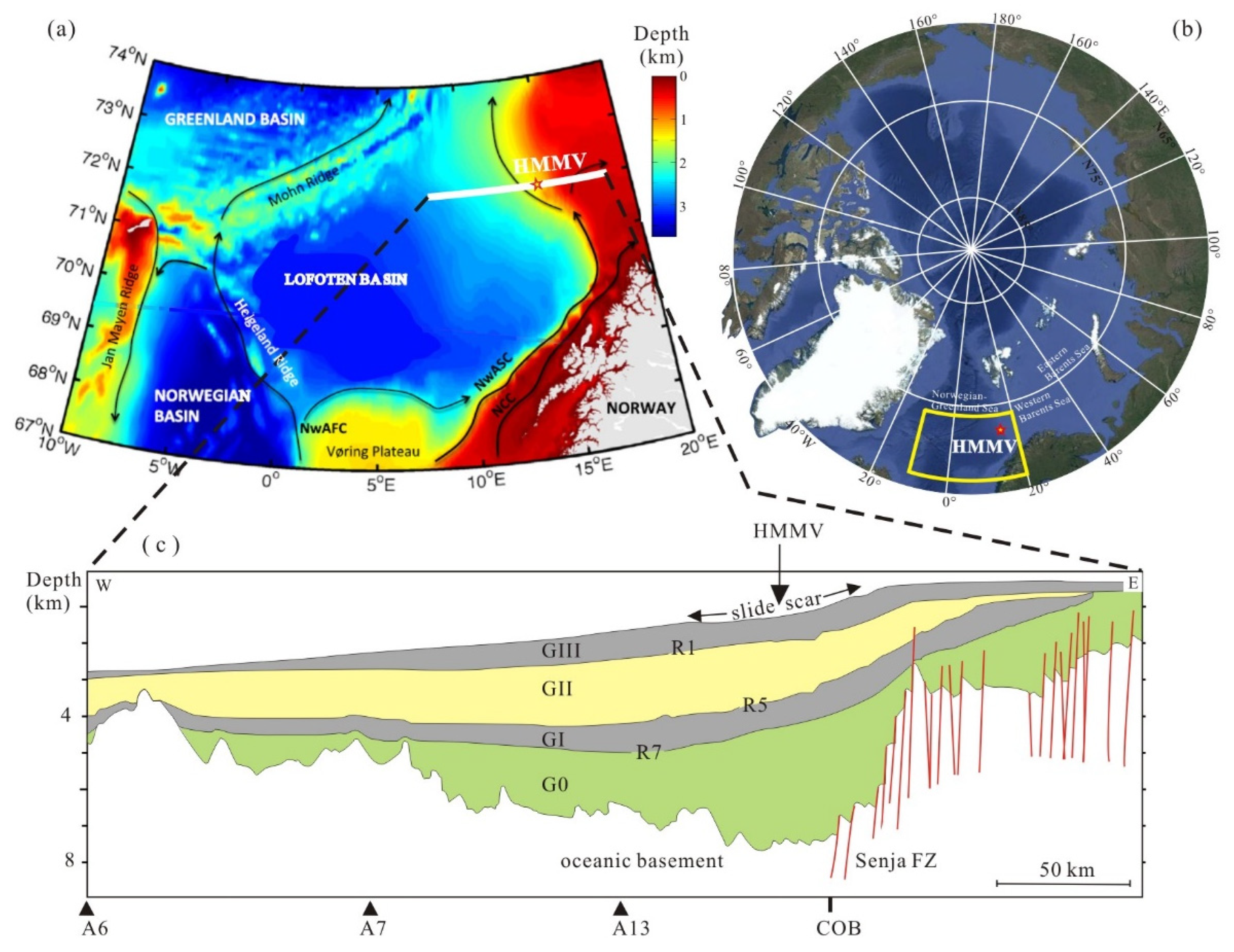
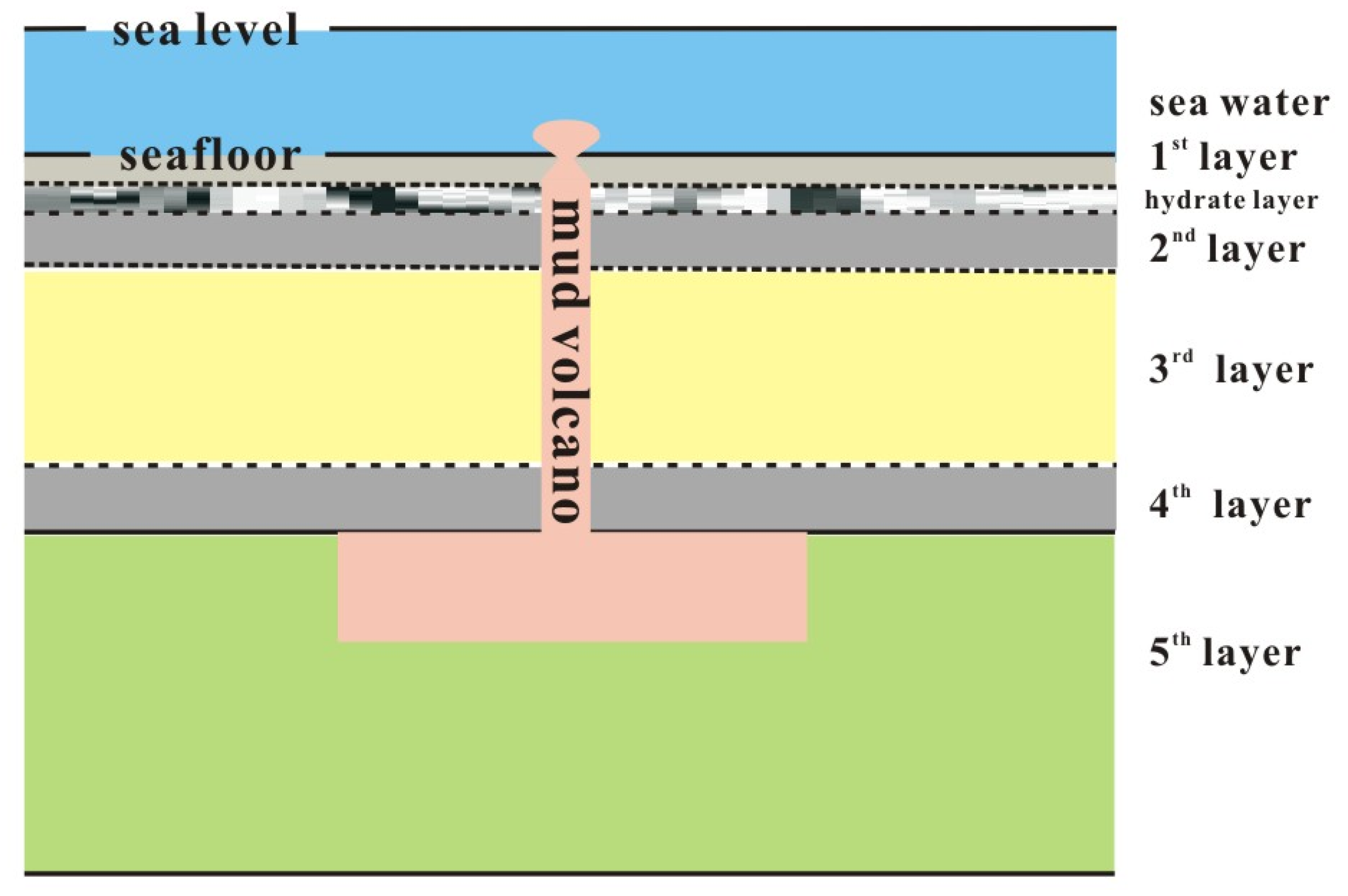

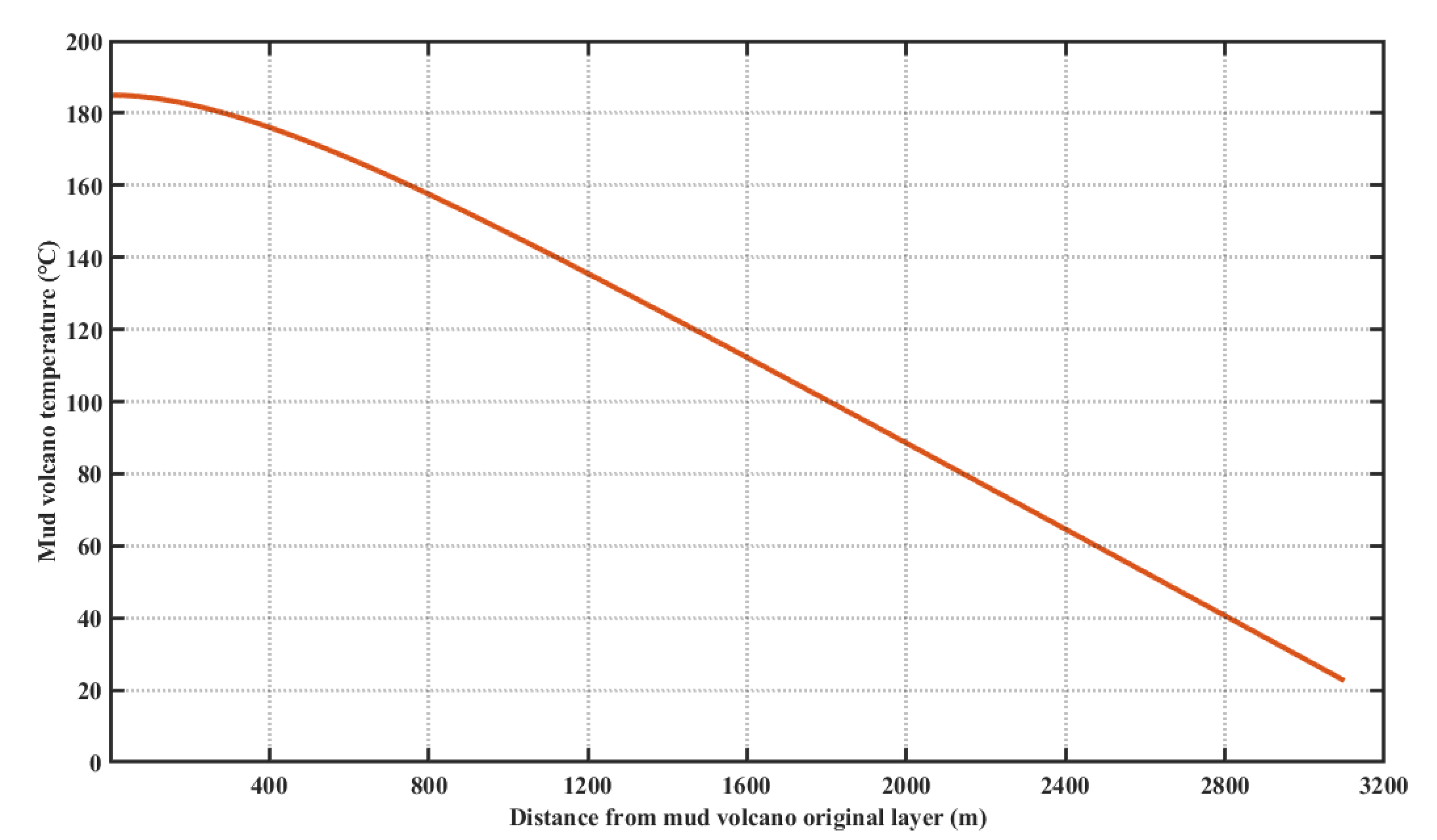
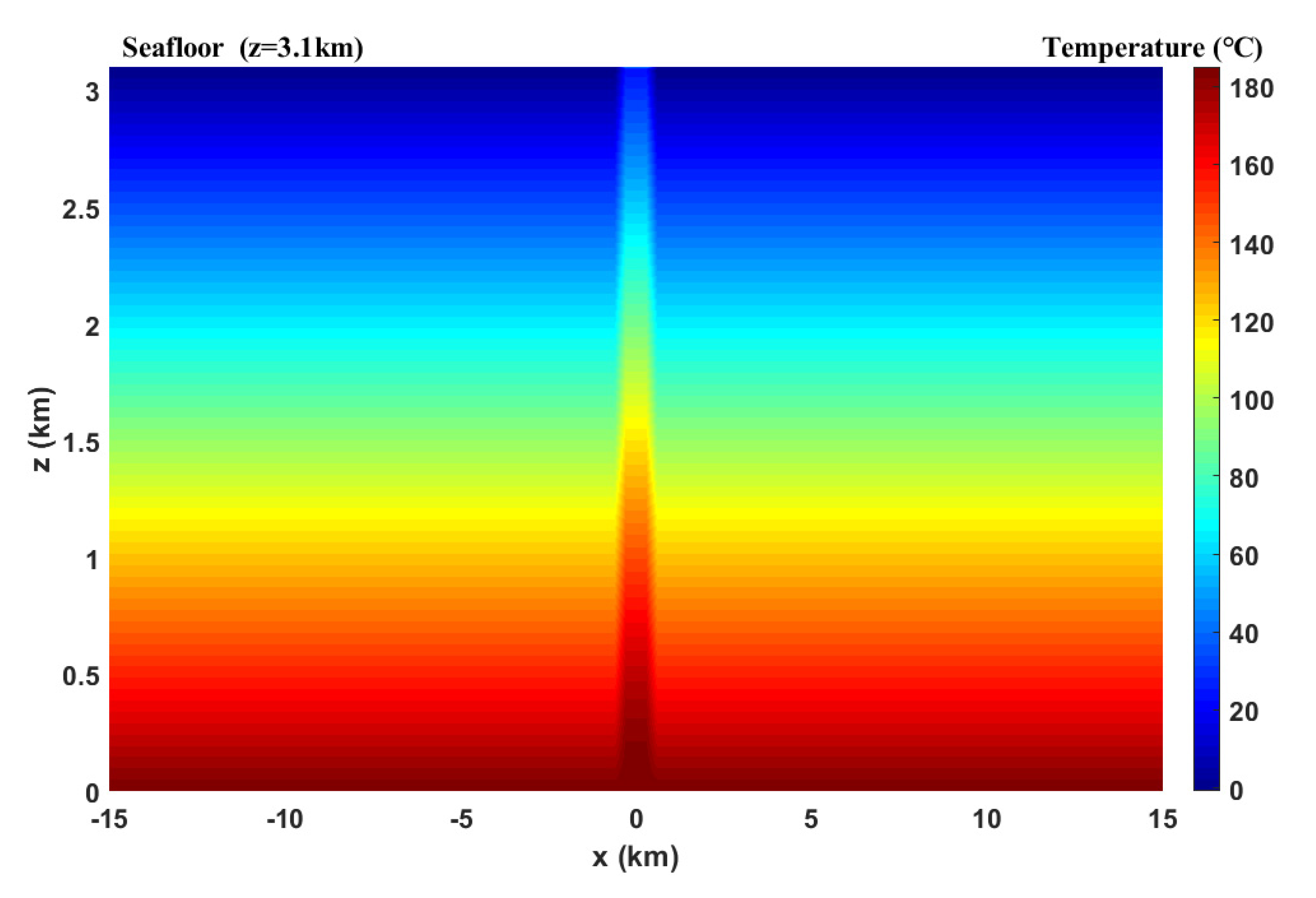
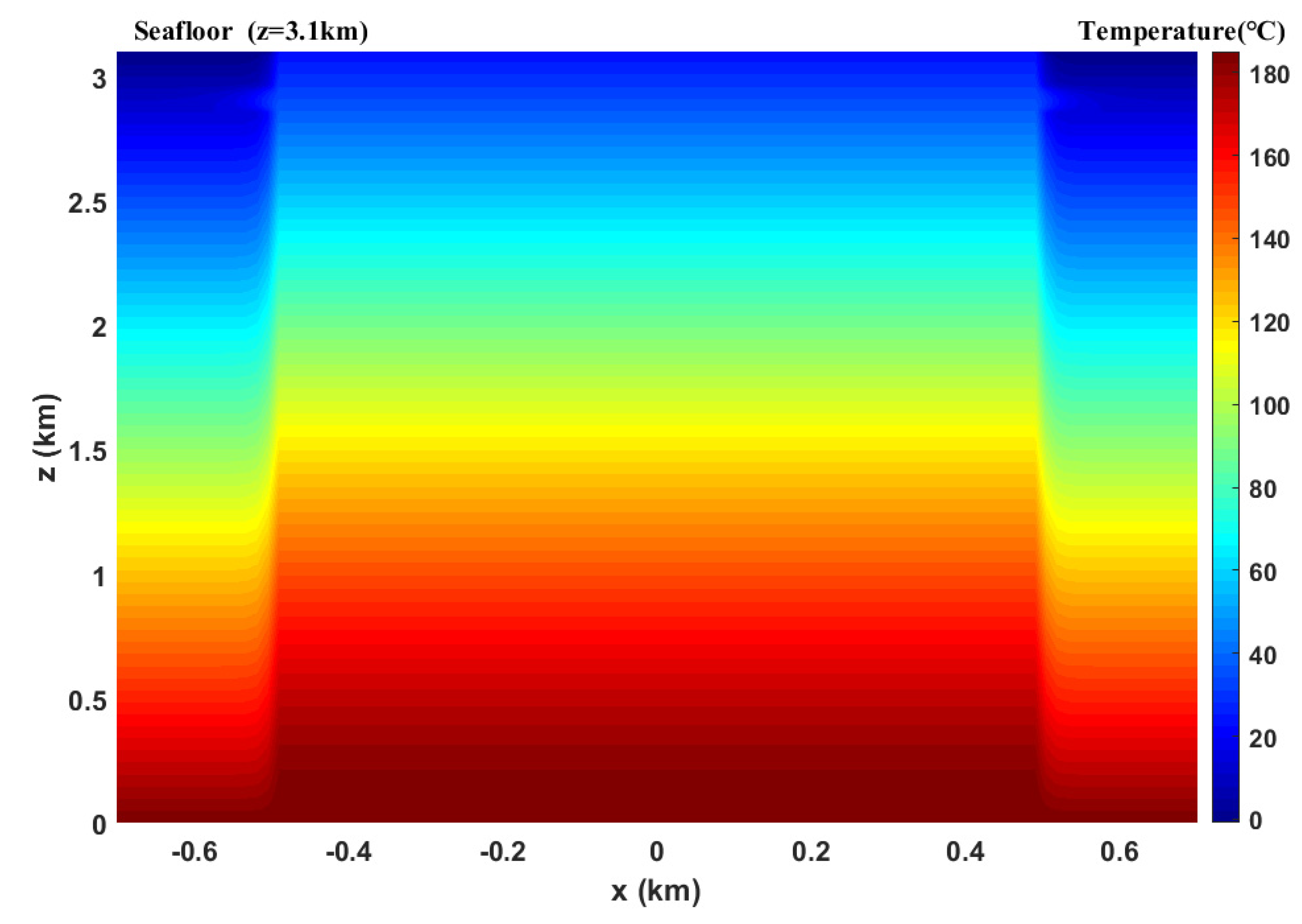
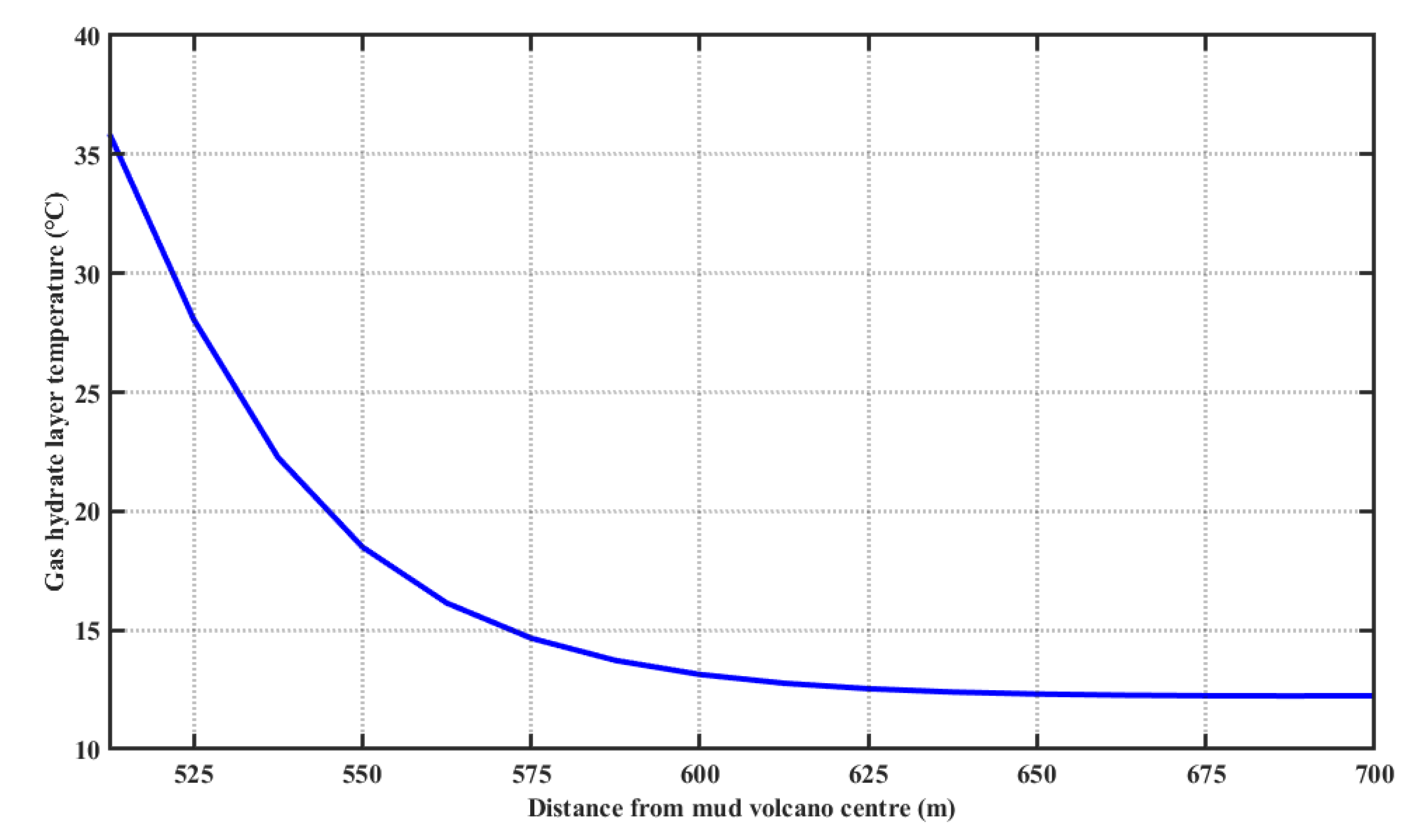

| Layer | Layer Type | Rock Type | Thickness | Thermal Conductivity | Density | Heat Capacity | Thermal Diffusivity |
|---|---|---|---|---|---|---|---|
| m | W/(m·k) | kg/m3 | J/(kg·K) | m2/s | |||
| L1 | Sea water | Water | 1250 | 0.56 | 1030 | 4220 | 1.29 × 10−7 |
| L1 | GIII-II | Sandy glacial muds | 140 | 1.53 | 2100 | 850 | 8.57 × 10−7 |
| L1 | Hydrate | Hydrate | 80 | 2.20 | 900 | 2040 | 1.20 × 10−6 |
| L2 | GIII-I | Sandy glacial muds | 480 | 1.53 | 2100 | 850 | 8.57 × 10−7 |
| L3 | GII | Sandy glacial muds | 1800 | 1.53 | 2100 | 850 | 8.57 × 10−7 |
| L4 | GI | Sandy glacial muds | 600 | 1.53 | 2100 | 850 | 8.57 × 10−7 |
| L5 | G0 | Biosiliceous oozes | 3200 | 2.07 | 2510 | 1180 | 6.99 × 10−7 |
| Parameter | Value | Unit | |
|---|---|---|---|
| c | specific heat capacity of mud volcano fluid | 1040 | J/(kg·k) |
| d | channel diameter | 1000 | m |
| r | channel radius | 500 | m |
| g | geothermal gradient | 0.06 | °C/m |
| k | thermal conductivity of fluid | 1.2 | W/(m·k) |
| h | 4.39 × 10−3 | W/(m2·k) | |
| v | fluid flow velocity | 9.51 × 10−9 | m/s |
| ρ | density of fluid | 1400 | kg/m3 |
| m | mass flow rate, m = πr2ρv | 10.45 | kg/s |
| p | channel perimeter, p = πd | 3140 | m |
| mean inlet temperature of the mud volcano | 185 | °C | |
| z | perpendicular distance from mud volcano original layer | variable | m |
| T(z) | temperature at z of the channel when the lateral surface temperature of channel changes with depth | variable | °C |
| Tw(z) | variable | °C | |
| Te(z) | temperature at z of the channel when the lateral surface temperature of channel did not change with depth | variable | °C |
| Ts | lateral surface temperature of the channel when it did not change with depth, a constant | constant | °C |
| Parameter | Unit | |
|---|---|---|
| α | thermal diffusivity coefficient of each layer | m2/s |
| ρ | density of each layer | kg/m3 |
| cp | specific heat capacity of each layer | J/(kg·k) |
| kx | thermal conductivity in x direction of each layer | W/(m·k) |
| kz | thermal conductivity in z direction of each layer | W/(m·k) |
| ∆t | the size of a time step | / |
| ∆x | node spacing in x and z spatial directions | / |
| ∆z | node spacing in x and z spatial directions | / |
| Depth(m) | Simulated Temperatures at the Center of Mud Volcano Channels (°C) | Simulated Temperatures of Unaffected Surrounding Strata (°C) |
|---|---|---|
| 0 | 22.62 | −0.80 |
| 10 | 23.28 | −0.37 |
| 220 | 35.87 | 12.20 |
| 1000 | 82.57 | 59.00 |
| 3000 | 184.30 | 179.00 |
Publisher’s Note: MDPI stays neutral with regard to jurisdictional claims in published maps and institutional affiliations. |
© 2022 by the authors. Licensee MDPI, Basel, Switzerland. This article is an open access article distributed under the terms and conditions of the Creative Commons Attribution (CC BY) license (https://creativecommons.org/licenses/by/4.0/).
Share and Cite
Wan, Z.; Luo, J.; Yang, X.; Zhang, W.; Liang, J.; Zuo, L.; Sun, Y. The Thermal Effect of Submarine Mud Volcano Fluid and Its Influence on the Occurrence of Gas Hydrates. J. Mar. Sci. Eng. 2022, 10, 832. https://doi.org/10.3390/jmse10060832
Wan Z, Luo J, Yang X, Zhang W, Liang J, Zuo L, Sun Y. The Thermal Effect of Submarine Mud Volcano Fluid and Its Influence on the Occurrence of Gas Hydrates. Journal of Marine Science and Engineering. 2022; 10(6):832. https://doi.org/10.3390/jmse10060832
Chicago/Turabian StyleWan, Zhifeng, Junsheng Luo, Xiaolu Yang, Wei Zhang, Jinqiang Liang, Lihua Zuo, and Yuefeng Sun. 2022. "The Thermal Effect of Submarine Mud Volcano Fluid and Its Influence on the Occurrence of Gas Hydrates" Journal of Marine Science and Engineering 10, no. 6: 832. https://doi.org/10.3390/jmse10060832
APA StyleWan, Z., Luo, J., Yang, X., Zhang, W., Liang, J., Zuo, L., & Sun, Y. (2022). The Thermal Effect of Submarine Mud Volcano Fluid and Its Influence on the Occurrence of Gas Hydrates. Journal of Marine Science and Engineering, 10(6), 832. https://doi.org/10.3390/jmse10060832







